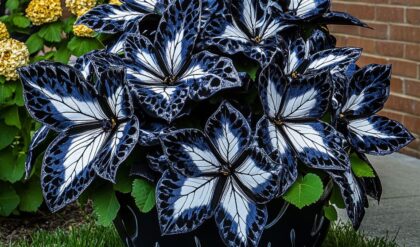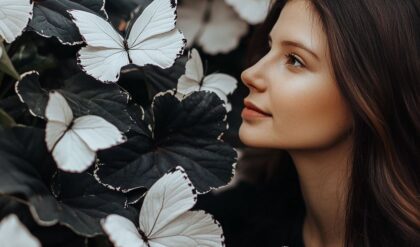Caladiums are stunning tropical plants known for their vibrant, heart-shaped leaves that come in a mesmerizing array of colors and patterns. These eye-catching plants can transform any garden or indoor space into a lush, exotic paradise. If you’ve ever wondered how to grow these beautiful plants from bulbs, you’re in for a treat. This comprehensive guide will walk you through the entire process of growing caladium bulbs, from dormancy to full, glorious bloom.

Understanding Caladium Bulbs
Caladium bulbs, also known as tubers, are the starting point for these magnificent plants. Understanding the nature of these bulbs is crucial for successful cultivation.
The Anatomy of a Caladium Bulb
Caladium bulbs are actually tubers, similar to potatoes. They have a rounded shape with a slightly flattened top. The top of the tuber, often referred to as the \eye\ or \ud end,\ new growth will emerge. This end is usually slightly pointed or has small bumps.
Dormancy Period
Caladium bulbs have a natural dormancy period, typically during cooler months. During this time, the bulbs are inactive and don’t require water or nutrients. Understanding this dormancy is key to proper storage and timing of planting.

Varieties of Caladium Bulbs
There are numerous varieties of caladium bulbs available, each producing leaves with unique colors and patterns. Some popular types include:
- Fancy Leaf Caladiums: These have large, heart-shaped leaves and come in various color combinations.
- Strap Leaf Caladiums: These have narrower, elongated leaves and are often more sun-tolerant.
- Lance Leaf Caladiums: These have arrow-shaped leaves and are typically smaller in size.
Understanding the different types can help you choose the best varieties for your specific growing conditions and aesthetic preferences.
Preparing for Planting
Before you can enjoy the beauty of caladium plants, proper preparation is essential. This stage sets the foundation for healthy growth and vibrant foliage.

Choosing the Right Time to Plant
Timing is crucial when it comes to planting caladium bulbs. These tropical plants thrive in warm conditions and are sensitive to cold. The best time to plant is after the last frost date in your area, typically in spring or early summer when soil temperatures have warmed to at least 65°F (18°C).
Selecting the Ideal Location
Caladiums prefer partial shade to full shade, depending on the variety. When selecting a planting location, consider the following:
- Light conditions: Most caladiums thrive in filtered sunlight or partial shade. Some varieties can tolerate more sun, but direct, intense sunlight can scorch the leaves.
- Protection from wind: Choose a location that offers some protection from strong winds, which can damage the delicate leaves.
- Soil drainage: Ensure the area has well-draining soil to prevent waterlogging, which can lead to bulb rot.
Preparing the Soil
Caladiums prefer rich, well-draining soil with high organic content. Follow these steps to prepare your soil:
- Test the soil pH: Caladiums prefer slightly acidic soil with a pH between 5.5 and 6.5.
- Amend the soil: If necessary, add organic matter such as compost or well-rotted manure to improve soil structure and fertility.
- Ensure good drainage: If your soil is heavy or clay-like, consider adding sand or perlite to improve drainage.
By taking the time to properly prepare for planting, you’ll create an ideal environment for your caladium bulbs to thrive and produce stunning foliage.

Planting Caladium Bulbs
Now that you’ve prepared the perfect environment, it’s time to plant your caladium bulbs. This process requires attention to detail to ensure optimal growth and development.
Proper Planting Techniques
Follow these steps for successful caladium bulb planting:
- Soak the bulbs: Before planting, soak the bulbs in lukewarm water for about an hour. This helps to rehydrate them and jumpstart growth.
- Determine planting depth: Plant caladium bulbs about 5-10cm (2-4 inches) deep. The larger the bulb, the deeper it should be planted.
- Positioning the bulb: Place the bulb with the pointed end or \ upward. This is where the new growth will emerge.
- Spacing: Space bulbs about 6-8 inches apart to allow room for growth. For a fuller display, you can plant them closer together.
- Backfill and water: Gently cover the bulbs with soil and water thoroughly to settle the soil around the bulbs.
Container Planting vs. In-Ground Planting
Caladiums can be grown successfully both in containers and in the ground. Each method has its advantages:
Container Planting:
- Allows for better control of soil conditions
- Easier to move plants to ideal light conditions
- Perfect for patios, balconies, or indoor growing
In-Ground Planting:
- Provides more space for root development
- Allows for larger, more dramatic displays
- Ideal for creating borders or mass plantings in shaded garden areas

Labeling and Record Keeping
When planting multiple varieties of caladiums, it’s important to label each planting area or container. This helps you keep track of different cultivars and their specific care requirements. Consider creating a garden journal to record:
- Planting dates
- Varieties planted
- Care routines
- Growth observations
This information will be invaluable for future plantings and help you refine your caladium growing skills over time.
Caring for Growing Caladiums
Once your caladium bulbs are planted, proper care is essential to ensure healthy growth and vibrant foliage. This section will cover the key aspects of caladium care.

Watering Requirements
Caladiums thrive in consistently moist soil, but they are sensitive to overwatering. Follow these watering guidelines:
- Frequency: Water deeply when the top inch of soil feels dry to the touch.
- Technique: Water at the base of the plants to avoid wetting the foliage, which can lead to fungal diseases.
- Mulching: Apply a layer of organic mulch around the plants to help retain moisture and regulate soil temperature.
- Drainage: Ensure containers have adequate drainage holes to prevent water from pooling.
Temperature and Humidity Considerations
Caladiums are tropical plants that prefer warm, humid conditions:
- Temperature: Maintain temperatures between 60-85°F (15-29°C) for optimal growth.
- Frost protection: If temperatures drop below 60°F (15°C), consider moving container plants indoors or providing frost protection for in-ground plants.
- Humidity: Aim for humidity levels of 50% or higher. Use a humidifier or place plants on pebble trays filled with water to increase humidity.

Fertilization Schedule
Proper fertilization is crucial for maintaining the vibrant colors and lush growth of caladiums:
- Type of fertilizer: Use a balanced, water-soluble fertilizer with equal parts nitrogen, phosphorus, and potassium (e.g., 10-10-10).
- Frequency: Fertilize every 4-6 weeks during the growing season.
- Application: Apply fertilizer to moist soil to prevent root burn.
- Slow-release option: Consider using a slow-release fertilizer at the beginning of the growing season for a steady nutrient supply.
By providing the right care in terms of watering, temperature, humidity, and fertilization, you’ll ensure your caladiums thrive and produce stunning foliage throughout the growing season.

Troubleshooting Common Issues
Even with the best care, caladiums can sometimes face challenges. Being able to identify and address common issues quickly is key to maintaining healthy plants.
Pest Management
Caladiums are generally resistant to pests, but they can occasionally be affected by:
- Aphids: These small, soft-bodied insects can cluster on new growth. Control them with insecticidal soap or a strong spray of water.
- Spider mites: These tiny pests thrive in dry conditions. Increase humidity and treat with neem oil or insecticidal soap.
- Slugs and snails: These can damage leaves, especially in damp conditions. Use slug baits or create barriers with diatomaceous earth.
Regular inspection of your plants can help catch pest problems early before they become severe.
Disease Prevention and Treatment
Caladiums can be susceptible to certain diseases, particularly in overly wet conditions:
- Fungal leaf spots: Caused by various fungi, these appear as brown or black spots on leaves. Improve air circulation and avoid overhead watering.
- Root rot: Caused by overwatering or poor drainage. Ensure proper drainage and allow soil to dry slightly between waterings.
- Rhizome rot: Similar to root rot, this affects the bulb itself. Remove affected bulbs and improve drainage.
Prevention is key – maintain proper watering practices and ensure good air circulation to minimize disease risk.

Addressing Nutrient Deficiencies
Nutrient deficiencies can manifest as discoloration or stunted growth:
- Yellowing leaves (chlorosis): Often a sign of nitrogen deficiency. Apply a balanced fertilizer.
- Purple or reddish leaves: May indicate phosphorus deficiency. Use a fertilizer higher in phosphorus.
- Brown leaf edges: Could be a sign of potassium deficiency. Use a fertilizer with higher potassium content.
Regular fertilization with a balanced fertilizer can help prevent most nutrient deficiencies.
Overwintering and Propagation
As the growing season comes to an end, it’s important to know how to properly overwinter your caladium bulbs and how to propagate them for an even more impressive display next year.
Preparing Caladiums for Dormancy
When temperatures begin to cool and leaves start to yellow, it’s time to prepare your caladiums for dormancy:
- Gradual water reduction: Slowly reduce watering as the foliage begins to die back naturally.
- Foliage removal: Once leaves have completely yellowed, cut them off at soil level.
- Digging up bulbs: For in-ground plants, carefully dig up the bulbs after the first frost.
- Cleaning: Gently brush off excess soil and allow bulbs to dry for a few days in a well-ventilated area.

Proper Storage Techniques
Storing caladium bulbs correctly during their dormant period is crucial for their survival:
- Temperature: Store bulbs in a cool, dry place with temperatures between 50-60°F (10-15°C).
- Containers: Place bulbs in breathable containers like paper bags or cardboard boxes.
- Packing material: Use dry peat moss, vermiculite, or sawdust to prevent bulbs from touching each other.
- Labeling: Clearly label containers with variety names for easy identification next season.
- Regular checks: Inspect bulbs periodically for signs of rot or mold, removing any affected bulbs.
Propagation Methods
Increase your caladium collection through these propagation methods:
- Division: When digging up bulbs, gently separate offsets (small bulbs attached to the main bulb). These can be planted separately next season.
- Leaf cuttings: Though less common, some caladium varieties can be propagated from leaf cuttings. Cut a leaf with a portion of the stem, place it in moist potting mix, and maintain high humidity.
- Seeds: While possible, growing caladiums from seeds is challenging and time-consuming. It’s generally not recommended for home gardeners.
By mastering these overwintering and propagation techniques, you can ensure a thriving caladium display year after year, expanding your collection and sharing the beauty of these plants with others.
Conclusion
Growing caladium bulbs is a rewarding experience that can add a tropical touch and vibrant colors to any garden or indoor space. By understanding the unique needs of these plants – from their dormancy period to their preference for warm, humid conditions – you can successfully cultivate stunning caladium displays.
Remember to start with high-quality bulbs, plant them in well-draining soil, and provide consistent care throughout the growing season. Pay attention to watering, temperature, and humidity levels to keep your caladiums thriving. Don’t forget to properly overwinter your bulbs to enjoy them again in the following year.
With the knowledge gained from this guide, you’re well-equipped to unlock the secrets of growing beautiful caladium bulbs. Whether you’re a seasoned gardener or a beginner, caladiums offer a unique opportunity to express your creativity and bring a touch of the tropics to your home or garden. Happy growing!



